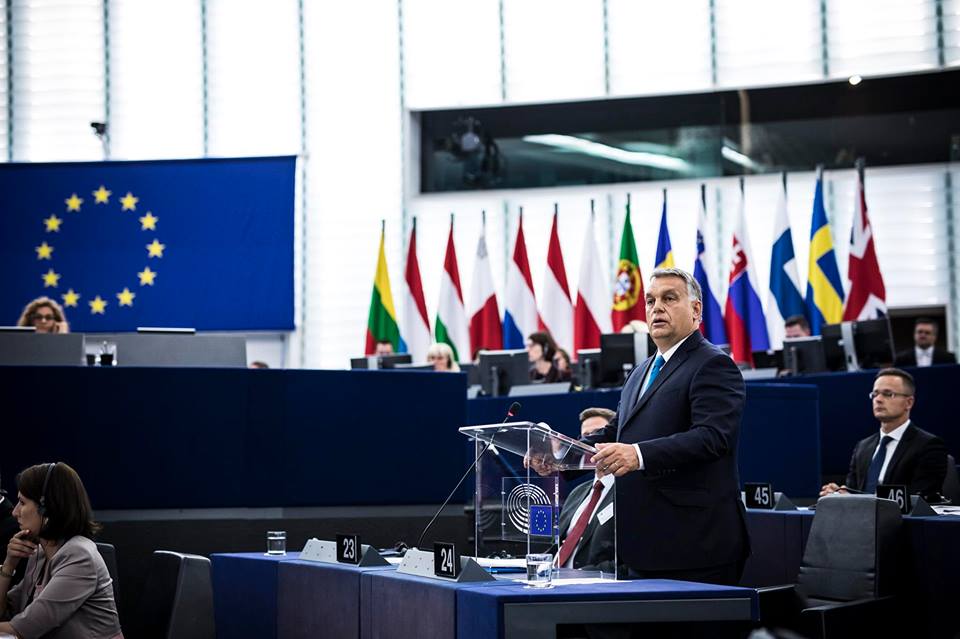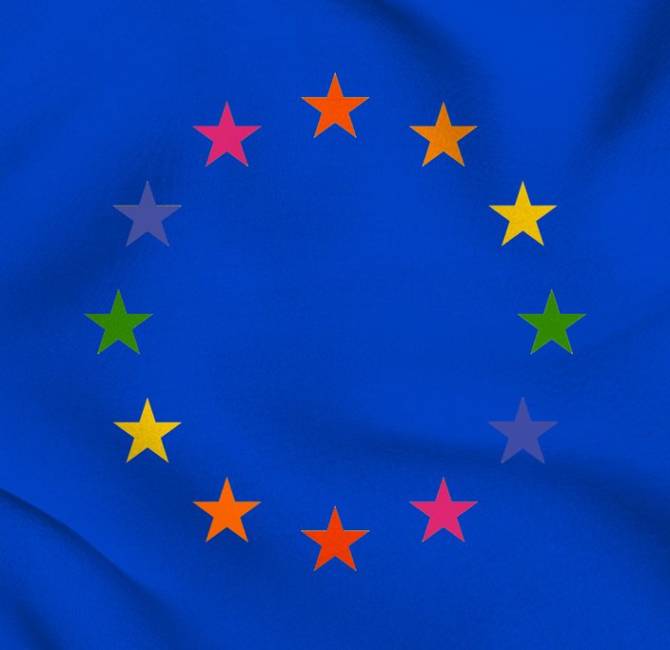This article has been suggested for a publication by several of our readers. The following article does not necessarily represent the views of the staff of the Visegrád Post. We are publishing it because we believe it offers an interesting perspective, but we do not endorse the author’s conclusions.
Published originally in French, on May 3, on gfaye.com and written by French polemic writer Guillaume Faye.
There is a worrying risk of a military clash between NATO and Russia over the Russian enclave of Kaliningrad, jammed between the Baltic countries and Poland, which are all new members of the EU and NATO. Military pressure keeps increasing in the Baltic region. The situation is far more dangerous than it was during the crisis of Eastern Ukraine and Crimea, because Kaliningrad is a Russian enclave at the core of the EU and NATO.
Officials and the Western media, as well as the governments of Poland and the three Baltic countries governments – and of course, Washington – are accusing Putin’s government of machiavellianism and ‘provocation’, seeking a casus belli with Kaliningrad. On the contrary, the Russians are the victims of a provocation: NATO is seeking an armed conflict, limited if possible, to be able to put down the regime of Putin that they hate so much. Will Kaliningrad be the pretext?
Poland and the Baltic governments are faking fear
The Kaliningrad province (Kaliningradskaïa Oblast) in the Northwest Federal District is a small Russian enclave between Lithuania and Poland. The main city, Kaliningrad, formerly Königsberg, was once a German city in East Prussia (Kant was from there). It has 450,000 inhabitants and it’s an interesting tourist and cultural destination.
In Vilnius and Warsaw, the authorities say they are worried about the ‘Russian military provocations’ in the form, according to them, of the militarization of Kaliningrad and the manoeuvrers of the Russian army. Former Lithuanian Prime Minister Andrius Kubilius, still an active politician, said he was ‘very worried about Russian military manoeuvrers so close to our borders’.
In Lithuania, where a protected rail corridor links Kaliningrad to Belarus and Russia, the authorities fear a ‘Russian provocation’. This same Andrius Kubilius, who also heads the Lithuanian Homeland Union (a centre-Right party), said in early April, ‘We fear a Russian provocation along the road and the rail corridors, or involving the high-voltage lines’. To deter this alleged Russian threat, which allows this faked fear to be carefully maintained in public opinion, the three Baltic governments formally requested an increase in the military presence of NATO on their soil. This is currently happening.
The ambassador of the Russian Federation to the European Union, Vladimir Chizhov, has said of the wishes of the Baltic leaders: ‘This request is motivated by domestic political calculations rather than for sincere reasons.’ The Polish Minister of Foreign Affairs, Witold Waszczykowski, said during a debate on NATO at a GLOBSEC conference in Bratislava in April 2016, ‘Russia is more dangerous than Islamic State’. This kind of talk by the representative of the Polish foreign policy establishment is a provocation on the part of a senior official who obeys orders.1
The content of anti-Russian propaganda
These orders come from the political and economic networks that innervate the leaders of the US and the EU. This is being done to portray Russia as a threat.
Dmitri Gorenburg, a military expert for the CNA Corporation think tank which is based in Arlington, Virginia, explained on Radio Free Europe (which has been the CIA’s propaganda station for decades): ‘Since tensions are getting worse with the West, Russia has found in Kaliningrad the ideal and obvious place to deploy military forces. From Kaliningrad you can threaten its neighbours; Sweden, Poland, and Germany are not that far away. Kaliningrad is a Russian military base operating at the core of European territory’. Gorenburg is concerned about the “strengthening of the Baltic fleet’s activities, which are based in Kaliningrad’, and suggests that Russian aggression is in preparation. This is nonsense.
A twelve-year-old looking at a map of the area would see the evidence: if Putin’s Russia wanted to attack the Baltics, Poland, and so on, she would not do it from the small enclave of Kaliningrad, which is far from the Russian mainland, vulnerable, and indefensible. She would launch an attack from her border with Latvia and Estonia! It is a geopolitical given.
The thesis of Washington, NATO, and Europe’s leaders – especially those of Poland and the Baltic states – is that Putin, plagued by internal economic difficulties, is a fanatical nationalist who seeks by all means to first, provoke an armed conflict with NATO; and second, to recover, as in the days of the Soviet Union, domination over Eastern Europe (Ukraine, the Baltic states, Poland, etc.). But this propaganda concerning the Russian threat is countered by the fact that the Russians would already be preparing for such military provocations and aggression if this were the case. For this, the CIA produced a clever montage worthy of Hollywood: the Russian military threat in Northern Europe.
The making of the Russian military threat
The Russian Baltic fleet, which is based at the port of Baltiysk in the enclave of Kaliningrad, is being strengthened, according to NATO. Planes taking off from air bases in the enclave – Chernyakhovsk and Donskoye – are violating the airspace of neighbouring countries, and are simulating attacks on American ships in the Baltic. The Russians have also increased their land forces in the enclave.
In April 2016, a Russian fighter-bomber made a close approach to an American frigate, the USS Donald Cook, and Russian fighters passed very close to American reconnaissance planes. American officials and NATO are talking about ‘Russian aggression’! These allegations followed a whole series of similar cases which have been taking place since 2014. The media has reported on incidents of Russian military aircraft violating the airspace of many countries, including Scandinavian Europe. There is no serious evidence that these acts of intimidation actually took place. It is the press services of NATO which claim that they did. Is this source reliable? Western journalists have posted questionable videos on the Internet of attacks by Russian aircraft. The CIA or other agencies are behind this disinformation campaign.
Washington and NATO have also expressed concern about the supposed presence of Iskander missiles in Kaliningrad. These are mounted on short-range mobile launchers with a range of 400 kilometres, and they can launch either conventional or nuclear warheads. They could reach either Warsaw or Berlin. In fact, in 2008, the Kremlin threatened to deploy these weapons if Washington persisted in building its anti-missile shield in Poland and the Czech Republic.
This argument is specious: why would Russia, which has missiles of all ranges which are able to reach anyplace in the world based on land and on submarines, need short-range missiles based in the Kaliningrad Oblast to attack her European neighbours? This is geopolitical stupidity. If Russia’s interest in attacking European countries isn’t obvious, Washington’s interest in provoking Russia is easier to understand, because Russia thus regains the status of a rival power, alongside China. This infuriates the ideologues of American supremacy and unilateralism who are behind Hillary Clinton, but who don’t like Donald Trump since he’s an isolationist.2
Manoeuvrers and military provocations against Russia
These military provocations against Russia aim to create an incident that would cause the situation to deteriorate. Warsaw’s government, which is truly anti-Russian, plans to obtain American Patriot anti-ballistic missiles, to defend against an imaginary Russian attack… Likewise, in March 2016, Poland also decided to buy American Tomahawk cruise missiles, which are are not at all defensive…
An American military convoy carrying heavy weaponry made a show of strength in Central and Eastern Europe to ‘reassure’ its allies in the event of eventual Russian aggression. NATO planes, including French ones, have been sent to the Baltic countries and to Poland.
According to The New York Times, the American authorities want to place heavy weaponry (tanks and artillery) in Eastern Europe and in the Baltic countries under the pretext of protecting the area against a Russian assault. The same article provided a reaction from a member of the Russian military, without giving his name: ‘This American action is the most aggressive one made by the Pentagon since the Cold War’. To accuse another, without any proof, of planning for armed aggression is, as we have known since Antiquity, a classic way to provoke a desired war. NATO Secretary General Jens Stoltenberg explains (Le Figaro, 2 April 2016) that the Alliance is going to deploy four battalions (about 4,000 men), and maybe more, in the Baltic countries and in Poland, along both the north and south of Kaliningrad. This is being done to prevent a Russian attack, under the pretext that the Kremlin has tripled its military spending since 2000 (which is false) and ‘violated Ukraine’s sovereignty’ (also false). Stoltenberg explains that this initiative ‘doesn’t violate’ the pact that NATO and Russia signed in Paris in 1997, which prohibits the stationing of ‘substantial fighting forces’ in Eastern Europe. Mr Sergei Lavrov and the Russian Foreign Ministry probably think the contrary, and any person with common sense thinks so, too.
The refusal of Russia as a great power
What worries Washington, like all the other Atlanticist spheres which govern the EU, is not the Russian military threat (which is an implausible hypothesis), but rather the fact that Russia is again becoming an important strategic power which might compete with the US.
Russia is going through an economic downturn which was caused by the decrease in petroleum prices which resulted from the Western sanctions during the Ukrainian crisis, which is illegal under international law. But this economic crisis is far less important than what the Western media pretends.
Russia has succeeded in reestablishing her military and strategic might following its initial post-Soviet weakness. This is worrying to Washington. In Syria and in Nagorno-Karabakh, Russian military interventions have been very efficient, more so than recent Western interventions. The efficiency level of the Russian military, both on the ground and in the air, is superior – the proof is in Syria – than that of the NATO countries. It has been said that only a ‘coalition’ led by the US was able to make the Islamic State retreat. But the Islamic State fell back on the field only thanks to the Russian forces that are supporting Bashar al-Assad’s. It worries the Pentagon, but above all, humiliates it.
The Russian defence budget has been increasing from 70 to 92 billion since 2011. It reached 4 per cent of its GDP, which is more than double that of the budgets of the European members of NATO. Since the end of the Yeltsin era, the Russian military has been vastly improving itself with the reduction of unneeded personnel, professionalization, the renovation of its equipment (such as the Sukhoi T-50 stealth plane, the T-14 heavy tank, and a fleet of 45 attack submarines), the modernisation of its nuclear capabilities, and so on.
More than 40 new intercontinental ballistic missiles are about to be added to the Russian arsenal. Putin isn’t ‘aggressive’, but obeys a logic that was fully understood by De Gaulle: to be credible and respected (diplomatically, economically, etc.), a great country has to have credible military deterrence. But Russian ‘militarism’ is a joke when one looks at the US military budget, which represents nearly half of global defence spending. Russia is threatening absolutely no one.
Unlike other sectors of its economy which are insufficiently developed, the Russian arms industry, along with hydrocarbons, space technology, and nuclear energy (Rosatom), is at the highest global level. ‘Strategically, the Russian intervention was more efficient than that of the Western coalition […] Diplomatically, Russia has imposed herself as an essential power in both Europe and the Middle East’, said Nicolas Baverez, a Russian analyst who is, however, opposed to Putin (Le Figaro, 25 April 2016). In Syria, the Russian strategy is ten times more skilful and efficient than the Western equivalent. All of this is completely intolerable for Washington and the Atlanticist spheres.
Anti-Russian hostility is geopolitical stupidity
Washington is seeking a military confrontation with Russia, if possible on a limited scale, by means of diverse methods of provocation. The aim is to put Putin down and halt Russia’s increasing power, and to impeach a European-Russian alliance. Of course it is a stupid and counterproductive strategy, but it is common for Washington’s bellicose leaders, as we can see in the catastrophes which have been brought about by American military interventions for decades.3
While absolutely no sign of Russian hostility against the Baltic countries or Poland exists, NATO is strengthening its military disposition in the area under the pretext of a Russian attack that is totally imaginary. Since tensions in Ukraine have lessened, the Russian enclave of Kaliningrad has become the centre for provocation, incidents, and causus belli opportunities.
To inspire believe in a nonexistent Russian threat and to provoke a direct, armed conflict with Russia, even on a limited scale, is one of the objectives of powerful lobbies in Washington, within NATO, and within the EU. They didn’t succeed in Eastern Ukraine and Crimea. They are now seeking to provoke an armed conflict in the Baltic region. This is geopolitically logical.
On six occasions the Western world, led by the Americans, has violated the UN Charter through military interventions, which are both illegal under international law and disastrous in their results, including in the Balkans against the Serbs, in Libya, and in Syria against Bashar al-Assad. It wouldn’t be a surprise if ‘incidents’ were manufactured with the aim of creating a conflict with disastrous consequences under the pretext of defending against a Russian threat from the Kaliningrad enclave.
At a time when Europe is threatened by a massive migratory invasion, which is mostly Muslim, and by Islamic terrorism, the Western leaders aren’t doing anything better than assigning Russia as their primary enemy and as the most urgent threat. Even though she is our unique ally…
Footnotes
- Polish Foreign Affairs Minister Waszczykowski hates Russia, but loves Turkey. He decided that Poland was going to support the abolition of the requirement for Turkish nationals to obtain visas to visit the European Union.
- Donald Trump defends a position abhorred by Washington’s elites, namely isolationism and the rejection of russophobia. His slogan, ‘America First’, signifies that America is concerned first of all with herself, without seeking to dominate or help anybody else. This is a good form of egoism.
- Those American industrial lobbies which are greatly involved in the arms industry, such as Boeing for example, have always pushed the government to maintain peripheral wars on a permanent basis in order to sell their wares to the Pentagon. American aggression is more economic than political or ‘militaristic’. I say all of this as a hater of americanophobia, which is just as stupid as russophobia.
Translated from French by the Visegrád Post.




